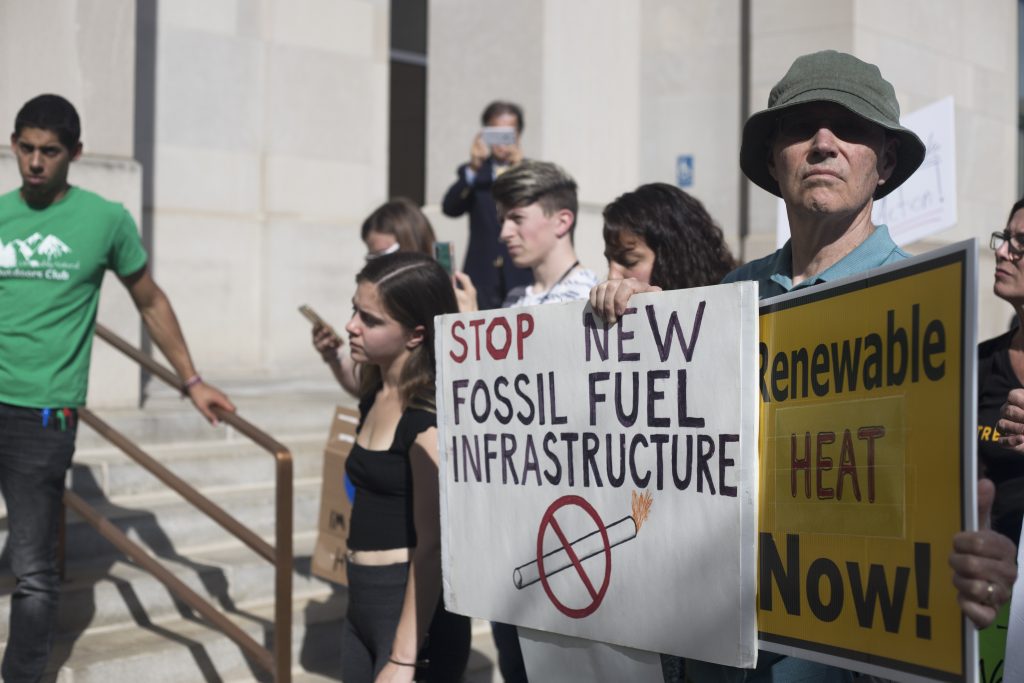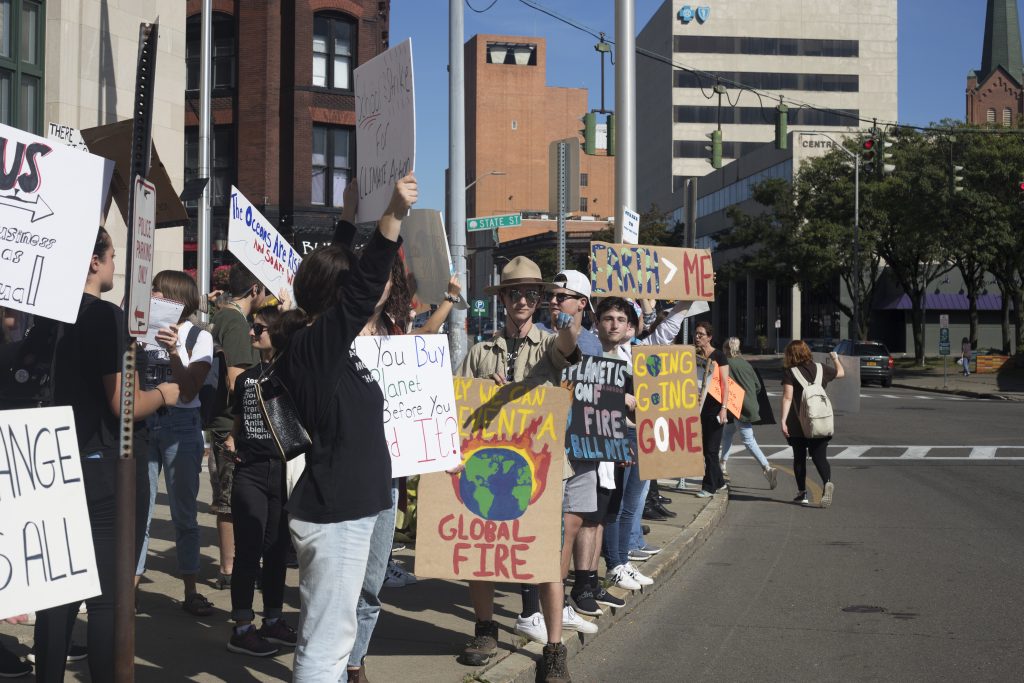
Binghamton University students and community residents held a Climate Strike in Downtown Binghamton on Friday as part of a global event that drew an estimated 600,000 protesters across the United States and 4 million worldwide, according to the U.S. Youth Climate Strike Coalition.
Speakers at the event warned that immediate action is needed to combat the existential threat posed by the effects of carbon emissions on global climate.
Dylan Feliciano, a senior majoring in philosophy, politics and law, was the event’s chief organizer and keynote speaker. Feliciano and four classmates from the Rhetoric 450: Communication, Ethics & Social Action course worked together as a group to organize the event. The class requires students to act as social justice activists throughout the semester, where each student picks a cause important to them and incorporates projects throughout the course — Feliciano and his group’s focus being climate change.
“I want to organize it, but I can’t do it by myself,” Feliciano said, recalling when he first recruited his classmates. “So if anybody else is interested, come and see me after class, and we’ll talk about it.”
Feliciano and his group launched Friday’s strike using internet tools such as strikewithus.org to spread the word. The result was a rally of more than 170 participants, many carrying signs, with the sound of honking horns signaling support from passing vehicles, including a school bus. The strike took place at 15 Henry St. in front of a federal building that includes the regional office of Sen. Chuck Schumer.
Feliciano said the Climate Strike was not aimed specifically at Schumer, but at Congress in general. However, he said he chose Schumer’s office because it represents the highest level of government with a presence in Binghamton, adding that the effort to demand action by Congress must be ongoing.
“We will take action, and we will be victorious,” Feliciano told the cheering crowd Friday.
Michael-Luca Natt, a junior majoring in environmental studies and one of the four original organizers of the event, said he was dismayed at the general lack of awareness on campus about the worldwide climate demonstrations.
“All around the world, people are coming out together, 1.4 million in Germany alone, and yet I’ll go around campus and ask people about climate change and they’re like, ‘What? What is that?’,” Natt said. “And I’m like, ‘How do you not know that? It’s happening all around the world.’”
For Feliciano, an immediate concern is to assist people already harmed by storms and floods. Furthermore, he said the federal government must help those who will have to change jobs and careers as a new economy based on investing in solar and wind energy replaces the one dependent on multibillion-dollar subsidies to the fossil fuel industries. He said he intends to continue with future strikes to get results.
The global movement evolved from a weekly solo protest by one Swedish teenager, 16-year-old Greta Thunberg, who skipped school every Friday last year to protest in front of the Parliament House in Stockholm, holding a sign in Swedish that translates to “School strike for the climate.” Since then, the young activist has been carrying her message around the world, influencing the creation of Friday’s global strike of 4 million people, which coincided with Thunberg’s appearance in New York City to speak at the United Nations Climate Action Summit.
Feliciano said he is a proponent of the Green New Deal, which includes measures to combat power dynamics, as people who are extremely wealthy can pollute almost with impunity.
“They have the power to move the levers of government, such as by bankrolling campaigns to elect government officials who will deregulate, lower emission standards and allow more pollution,” Feliciano said.
Although students organized this strike, older adults were also represented. Tina Logerfo, 59, of Newark Valley, said climate change is a main factor in her voting decisions.
“It’s the number-one priority I’m voting on, what’s going on with our climate,” Logerfo said. “It’s important to all ages, not just the young.”
Owen Jarrold, 22, of Apalachin, said climate change could lead to the end of humanity. Despite this, Jarrold said there is hope in local communities.
“If I had to put it into words, it’s kind of like a fear, like an anxiety — just worrying about what the future holds,” Jarrold said. “I think it’s important to start small with local governments, with who’s representing your city and people who have [environmental] interests in mind. It’s easy to get overwhelmed, but we can set an example.”
Ryan Martin, Schumer’s deputy regional director, came out of the building as the strike was dispersing, thanked the strikers for expressing their concerns and said he would take their message back to the senator.
Martin also referred demonstrators to Schumer’s Twitter account, which had a video of the senator talking about his grandson and expressing concern about the future, but did not advertise any climate change legislation that he is currently drafting or supporting.
Next week, another climate change protest will take place in Downtown Binghamton. Organizers expect a larger turnout to occur at a Climate Strike event on Friday, Sept. 27 at the Peacemaker’s Stage, as middle-school and high-school students plan to join with University students and community activists to raise awareness of the severity and urgency of climate change and the need for immediate remedial action.
Editor’s note: Copy Desk Chief Lia Berger assisted in organizing Friday’s Climate Strike and did not contribute to this article.



